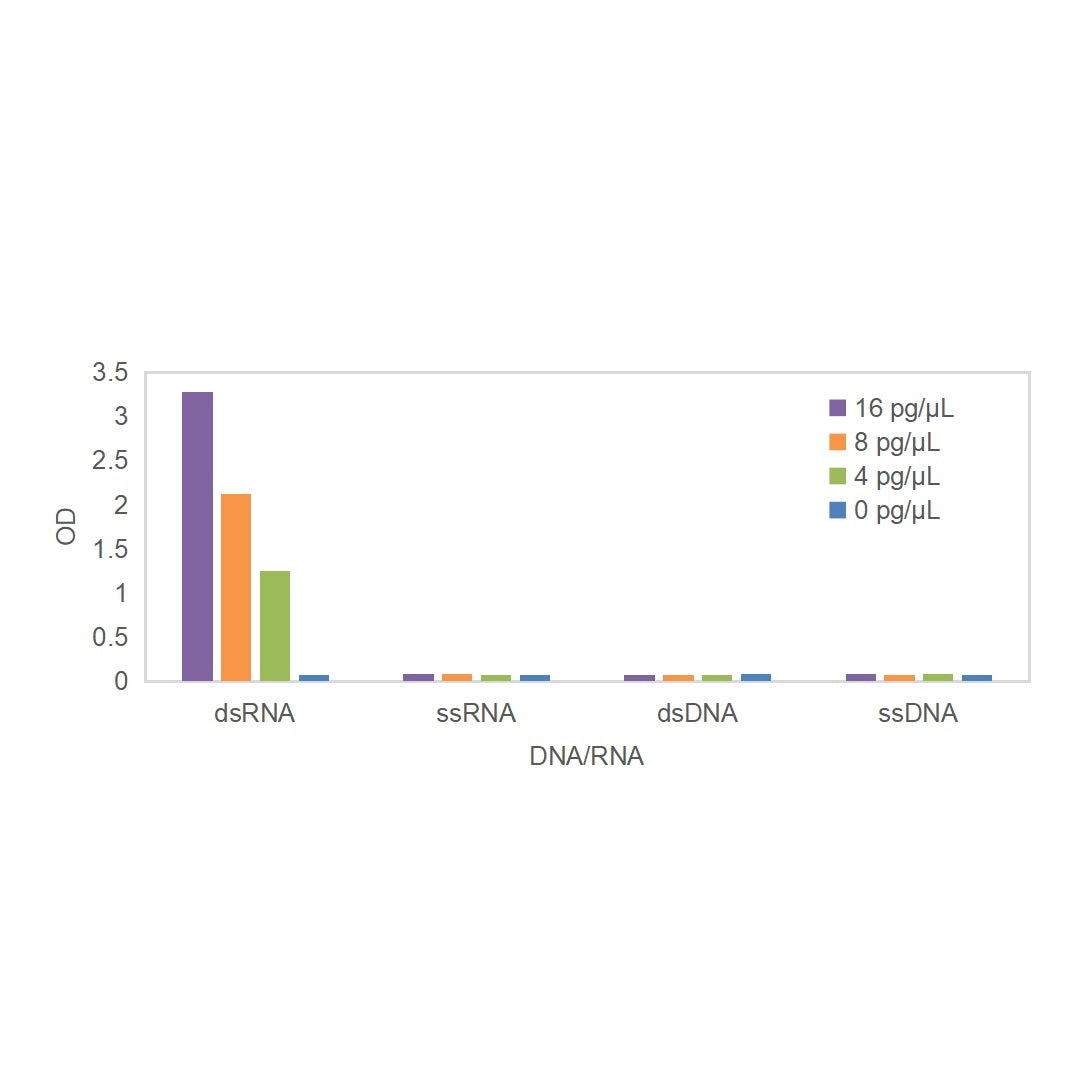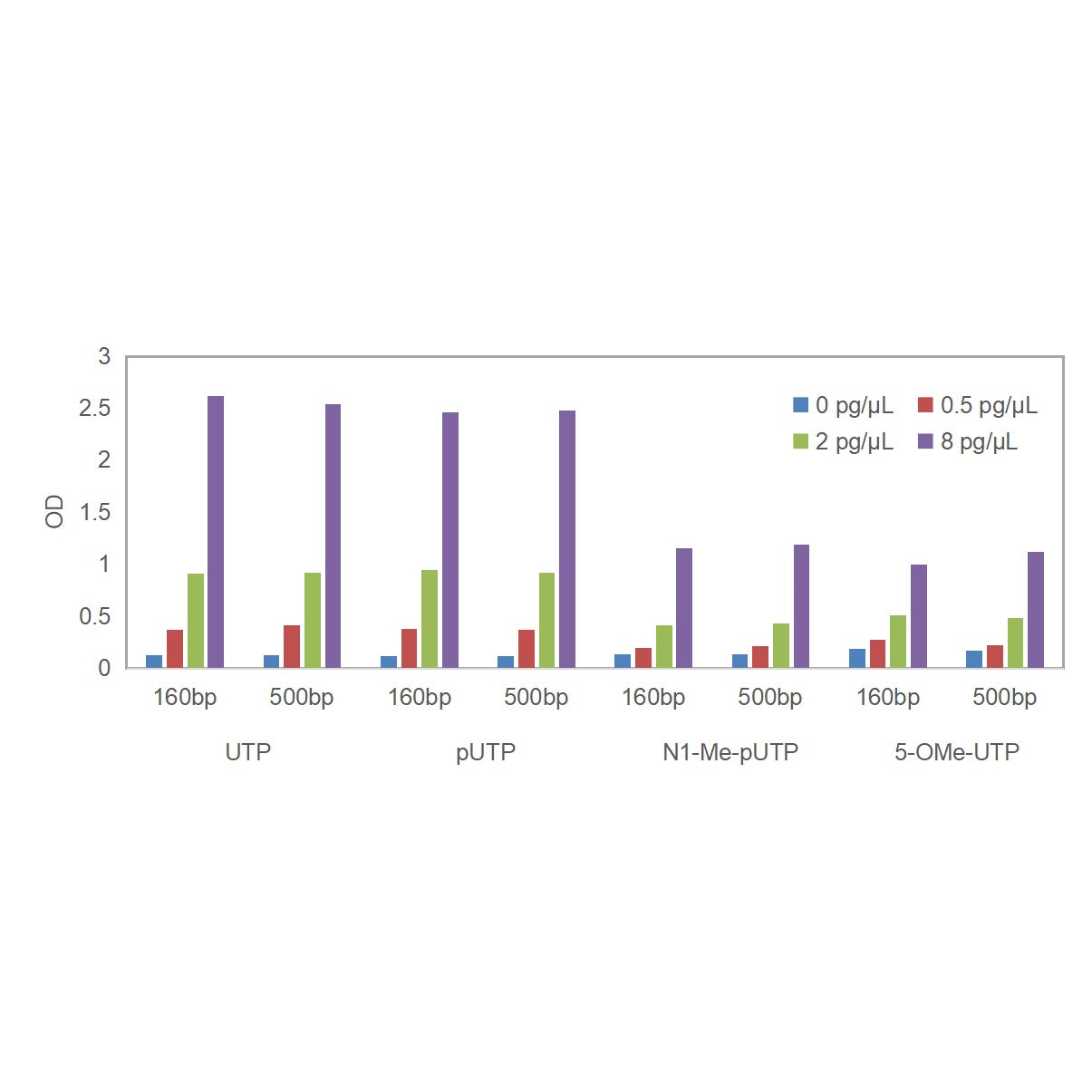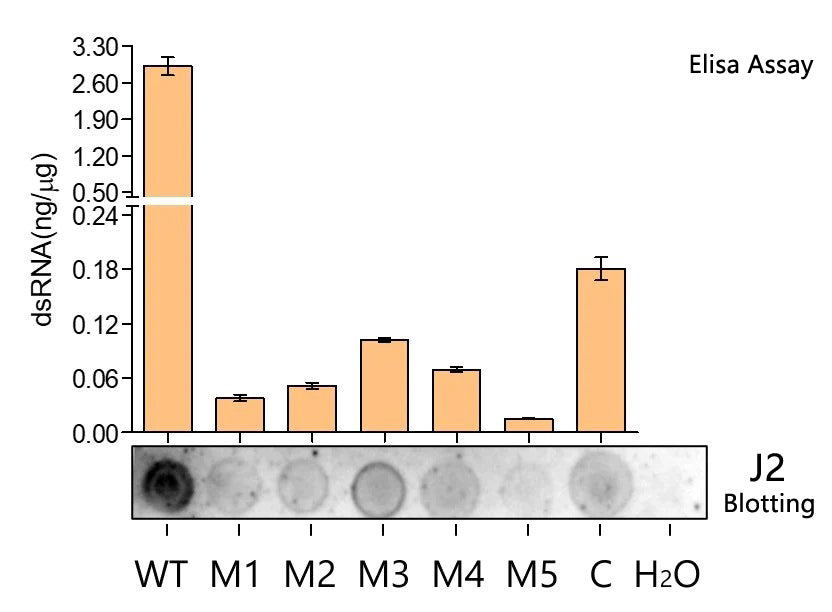Description
Double-stranded RNA (dsRNA) emerges as a by-product during the in vitro transcription of mRNA. This by-product possesses immunogenic properties within the human body, capable of provoking an immune response, consequently diminishing mRNA levels. This renders dsRNA a troublesome process impurity necessitating thorough elimination and stringent control of its residual presence.
To address this concern, the Double-stranded RNA (dsRNA) ELISA detection kit employs the experimental principles of a double-antibody sandwich enzyme-linked immunoassay (ELISA) for the quantification of residual dsRNA. The Kit can not only be used in the detection of regular dsRNAs, but also in detection of peudo UTP, N1-Me-peudo UTP and 5-OMe-UTP modified dsRNAs.
The procedure involves adding both a standard and the test sample onto an enzyme plate (designated as 36717-A) previously coated with anti-dsRNA antibodies. Subsequently, biotin-labeled dsRNA detection antibodies (36717-F) are added in a diluted form. Finally, Streptavidin-HRP (SA-HRP) (36717-G) is introduced to create a complex comprising antibodies, antigens, biotin, and SA-HRP.
Following plate washing, the addition of TMB chromogenic solution (36717-K) initiates color development. Under the influence of HRP enzyme catalysis, TMB undergoes a transformation from colorless to blue, which is then halted through the application of the stop solution (36717-L). Ultimately, this transformation results in a yellow hue, the intensity of which correlates positively with the quantity of dsRNA identified in the sample.
This kit serves a versatile purpose, enabling optimization of the biological product purification process, impurity control during intermediate stages, and release testing for final product assessment.
Features
High Sensitivity: Quantitative lower limit (LLOQ) reaches 0.0156 pg/μL; detection limit (LLOD) ≤0.001 pg/μL.
High Precision: Intra-assay CV <10%; intermediate precision (inter-assay CV) <15%.
High Accuracy: Spike recovery rates consistently between 70–130%.
Strong Specificity: No significant interference observed when different types of dsRNA are added to samples.
Excellent Stability: Kit remains stable for 7 days at 37 °C without affecting performance.
Regulatory Compliance: Fully validated according to ChP, USP, ICH Q2 (R2), and other relevant guidelines.
Audit-Ready Manufacturing: Stable production processes with controllable lot-to-lot variation and complete audit documentation.
Quality Assurance: All critical raw materials, including coated and detection antibodies and standards, are independently developed and fully traceable.
Specifications
|
Parameter |
Specification |
|
Detection Range |
STD1 (Unmodified dsRNA standard): 0.0156–1 pg/μL STD2 (pUTP modified dsRNA standard): 0.0156–1 pg/μL STD3 (N1-Me-pUTP modified dsRNA standard): 0.0312–2 pg/μL STD4 (5-OMe-UTP modified dsRNA standard): 0.0312–2 pg/μL |
|
Detection Range |
1 – 32 ng/mL |
|
Assay Method |
Double-antibody sandwich |
|
Assay Time |
3.5 hours |
|
Sensitivity |
STD1 (Unmodified): ≤0.001 pg/μL STD2 (pUTP modified): ≤0.001 pg/μL STD3 (N1-Me-pUTP modified): ≤0.001 pg/μL STD4 (5-OMe-UTP modified): ≤0.01 pg/μL |
|
Dilution Linearity |
Difference <20% compared with undiluted samples |
|
Recovery Rate |
70% – 130% |
|
Intra-assay Variation |
<10% |
|
Inter-assay Variation |
<15% |
Components
|
Components No. |
Name |
36717S48 (48 T) |
36717ES96 (96 T) |
|
36717-A |
Anti-dsRNA coated microtiter strips |
48 T |
96 T |
|
36717-B |
STD 1: unmodified, 5 ng/μL |
7.5 μL |
15 μL |
|
36717-C |
STD 2: pUTP modified, 5 ng/μL |
7.5 μL |
15 μL |
|
36717-D |
STD 3: N1-Me-pUTP modified, 5 ng/μL |
7.5 μL |
15 μL |
|
36717-E |
STD 4: 5-OMe-UTP modified, 5 ng/μL |
7.5 μL |
15 μL |
|
36717-F |
Detection Antibody:Biotin-conjugated Antibodies (100x) |
60 μL |
120 μL |
|
36717-G |
Streptavidin-HRP (100x) |
60 μL |
120 μL |
|
36717-H |
Dilution Buffer 1 |
25 mL |
50 mL |
|
36717-I |
Dilution Buffer 2 |
15 mL |
30 mL |
|
36717-J |
Wash Buffer Concentrate(20×) |
20 mL |
40 mL |
|
36717-K |
TMB Substrate |
6 mL |
12 mL |
|
36717-L |
Stop Solution |
3 mL |
6 mL |
|
36717-M |
Plate Sealer |
2 |
4 |
Storage
Store at 2-8°C. The shelf life is 1 year when unopened, and 6 months after opening.
Upon receipt of the product, please check if all components are complete, and immediately store them at the corresponding storage temperature.
Figures
1. Workflow

2. Good Linearity
Table 1. Standard curve of unmodified dsRNA reference material (STD1).
|
Standard Concentration (pg/μL) |
AVG(ng/mL) |
Recovery(%) |
CV% |
|
1 |
1.0001 |
100.0% |
3.1% |
|
0.5 |
0.4994 |
99.9% |
2.4% |
|
0.25 |
0.2516 |
100.7% |
3.3% |
|
0.125 |
0.1227 |
98.1% |
0.5% |
|
0.0625 |
0.0640 |
102.5% |
3.2% |
|
0.0312 |
0.0309 |
99.2% |
1.3% |
|
0.0156 |
0.0157 |
100.4% |
3.2% |
|
0 |
/ |
/ |
/ |
The linear range is 0.0156–1 pg/μL with R² > 0.99, and the coefficient of variation (CV) of replicate measurements at each concentration is <10%.
3. High Specificity
(A) .Specificity – Recognition of different types of nucleic acids
This assay specifically detects dsRNA and shows no reactivity with ssRNA, dsDNA, or ssDNA.
Table 2. Nucleic acid recognition profile of the antibody pair in the kit towards different types of nucleic acids.
|
Antigen concentration (pg/μL) Test Type |
dsRNA |
ssRNA |
dsDNA |
ssDNA |
|
OD Value |
||||
|
16 |
3.284 |
0.086 |
0.081 |
0.085 |
|
8 |
2.128 |
0.089 |
0.084 |
0.083 |
|
4 |
1.252 |
0.082 |
0.081 |
0.085 |
|
0 |
0.084 |
0.077 |
0.086 |
0.081 |
(B) .Specificity – Influence of dsRNA length and sequence

Figure 1. Detection of dsRNA molecules of different lengths and sequences using the assay.
dsRNAs of different lengths and sequences were tested using the four reference standards included in the kit.
The results show that the assay's measurements are largely unaffected by dsRNA sequence or length.
(A) .Specificity – Anti-interference
To evaluate potential interference, an mRNA sample was spiked with T7 RNA polymerase, RNase inhibitor (RI), inorganic pyrophosphatase (IPPA), DNase I, vaccinia capping enzyme (VCE), 2′-O-methyltransferase (MT), 1× IVT buffer, and 1 mM sodium citrate. A dsRNA standard with N1-methyl-pseudouridine modification was used for calibration and testing.
Results showed that none of the added enzymes or buffers affected dsRNA detection, and recovery rates remained within 80–120%.
Table 3. dsRNA test results from mRNA samples supplemented with eight different enzymes and corresponding buffers.
|
Sample Types |
dsRNA Test Concentration (pg/μL) |
Concentration(ng/mL) |
|
mRNA |
0.6057 |
100% |
|
mRNA+T7 RNA Polymerase (15μg/mL) |
0.5411 |
89.32% |
|
mRNA+Murine RNase Inhibitor (27.5μg/mL) |
0.5142 |
84.88% |
|
mRNA+Inorganic Pyrophosphatase (IPPA 10 μg/mL) |
0.7132 |
117.7% |
|
mRNA+DNase I (13.75 μg/mL) |
0.6077 |
100.32% |
|
mRNA+Vaccinia Capping Enzyme (10 μg/mL) |
0.6563 |
108.3% |
|
mRNA+2´-O-Methyltransferase (10 μg/mL) |
0.5776 |
95.4% |
|
mRNA+1×IVT buffer |
0.5003 |
82.6% |
|
mRNA+1mM Sodium citrate |
0.6251 |
103.2% |
4. High Accuracy: Spike recovery rates consistently within 80–120%.
An mRNA sample with a known dsRNA content of 0.36 pg/μL was spiked with 0.5 pg/μL unmodified dsRNA standard at three volume ratios (1:1, 1:20, 1:250). In all cases, the recovery rate met the 80–120% acceptance range.
Table 4. Dilution Linearity and Spike Recovery
|
Sample Type |
Standard/sample volume ratio |
dsRNA test value (pg/μL) |
Recovery (%) |
|
Test sample (TS) |
/ |
0.36 |
/ |
|
TS + 0.5 pg/μL unmodified dsRNA |
1:1 |
0.769 |
81% |
|
TS + 0.5 pg/μL unmodified dsRNA |
1:20 |
0.777 |
82% |
|
TS + 0.5 pg/μL unmodified dsRNA |
1:250 |
0.803 |
82% |
Documents
Safety Data Sheet
Manuals
36717_Manual_Ver.EN20250926.pdf
Payment & Security
Your payment information is processed securely. We do not store credit card details nor have access to your credit card information.
Inquiry
You may also like
FAQ
The product is for research purposes only and is not intended for therapeutic or diagnostic use in humans or animals. Products and content are protected by patents, trademarks, and copyrights owned by Yeasen Biotechnology. Trademark symbols indicate the country of origin, not necessarily registration in all regions.
Certain applications may require additional third-party intellectual property rights.
Yeasen is dedicated to ethical science, believing our research should address critical questions while ensuring safety and ethical standards.



